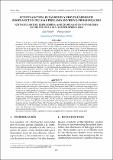Por favor, use este identificador para citar o enlazar este ítem:
https://hdl.handle.net/20.500.12958/8440| Título : | Ictioplancton, eufáusidos y biovolúmenes de zooplancton del mar peruano, invierno-primavera 2015 |
| Otros títulos : | Ichthyoplankton, euphausiids, and zooplankton biovolumes in the Peruvian sea (winter-spring 2015) |
| Autor : | Pinedo, Elda Ayón Dejo, Patricia |
| Palabras clave : | Engraulis ringens;Nyctiphanes simplex;Biovolúmenes;Zooplancton |
| Fecha de publicación : | dic-2023 |
| Editorial : | Instituto del Mar del Perú |
| Citación : | Pinedo, E. & Ayón, P. (2023). Ictioplancton, eufáusidos y biovolúmenes de zooplancton del mar peruano, invierno-primavera 2015. Bol Inst Mar Perú, 38(2), 195-214. |
| Resumen : | Se presentan los resultados del análisis de muestras de zooplancton recolectadas durante el Crucero de Evaluación Hidroacústica de Recursos Pelágicos 1508-10, ejecutado del 20 de agosto al 8 de octubre 2015, desde Punta Sal hasta Morro Sama. Fueron determinados huevos y larvas de 37 familias y 51 especies de ictioplancton. Huevos y larvas de anchoveta fueron más abundantes con valores que fluctuaron entre 3 y 14.640 huevos.m-2, así como entre 3 y 1.743 larvas.m-2. Las mayores zonas de desove estuvieron localizadas en la zona costera desde Pimentel hasta San Juan de Marcona y frente a Mollendo, y por fuera de las 20 mn entre Chimbote y Huarmey, mientras que las larvas tuvieron importantes concentraciones dentro de la plataforma continental entre Malabrigo y Supe. Los huevos y larvas de vinciguerria también fueron importantes por sus abundancias, con valores entre 3 y 3.078 huevos.m-2 y 3 y 342 larvas.m-2, distribuyéndose por fuera de la plataforma continental. Asimismo, 13 especies de eufáusidos fueron determinadas, siendo Nyctiphanes simplex la especie más abundante y frecuente, distribuida desde Punta Sal hasta San Juan de Marcona. Los biovolúmenes de zooplancton oscilaron entre 0,010 y 3,014 mL.m-3, siendo los biovolúmenes menores a 0,255 mL.m-3 más frecuentes (47 %), distribuidos principalmente en la zona costera. Las abundancias y distribución de los grupos reportados se asociaron a las condiciones ambientales registradas durante el crucero. ABSTRACT: This paper presents the results from the analysis of zooplankton samples collected during the Hydroacoustic Pelagic Resources Cruise 1508-10, conducted from August 20 to October 8, 2015, spanning from Punta Sal to Morro Sama. We identified eggs and larvae from 37 families and 51 species of ichthyoplankton. Engraulis ringens eggs and larvae were the most abundant, ranging from 3 to 14,640 eggs.m-2 and from 3 to 1,743 larvae.m-2. The primary spawning areas were along the coastal zone from Pimentel to San Juan de Marcona and off Mollendo. Additionally, there were significant larval concentrations within the continental shelf between Malabrigo and Supe. V. lucetia also showed noticeable abundances, ranging from 3 to 3,078 eggs.m-2 and from 3 to 342 larvae.m-2, distributed beyond the continental shelf. A total of 13 species of euphausiids were identified, with Nyctiphanes simplex being the most abundant and frequent species, found from Punta Sal to San Juan de Marcona. Zooplankton biovolumes ranged from 0.010 to 3.014 mL.m-3, with biovolumes less than 0.255 mL.m-3 being more prevalent (47 %), primarily in the coastal zone. The abundance and distribution of these groups were closely linked to the environmental conditions observed during the cruise. |
| URI : | https://hdl.handle.net/20.500.12958/8440 |
| ISSN : | 04587766 |
| Aparece en las colecciones: | Boletín 38(2) 2023 |
Ficheros en este ítem:
| Fichero | Descripción | Tamaño | Formato | |
|---|---|---|---|---|
| Boletin 38-2 articulo2.pdf | 1,23 MB | Adobe PDF |  Visualizar/Abrir |
Este ítem está sujeto a una licencia Creative Commons Licencia Creative Commons

